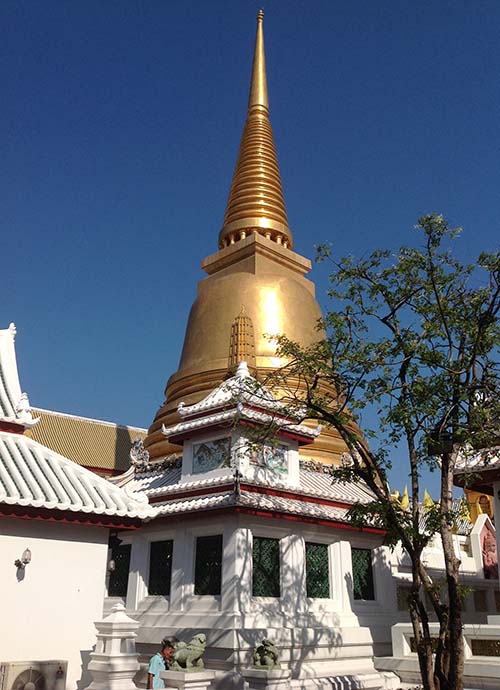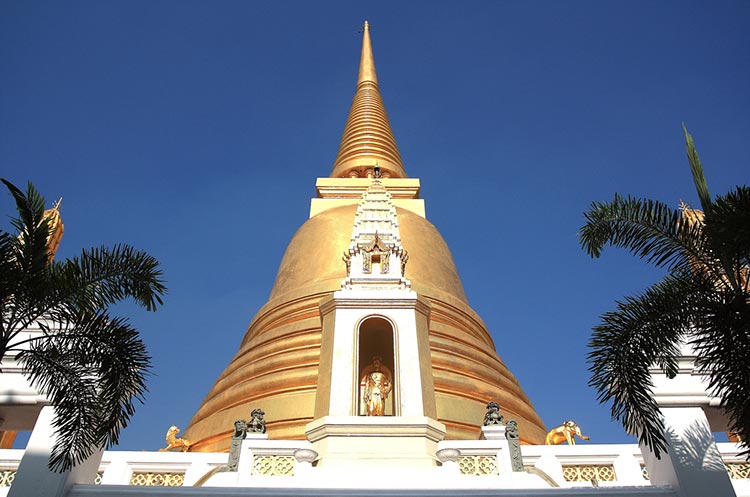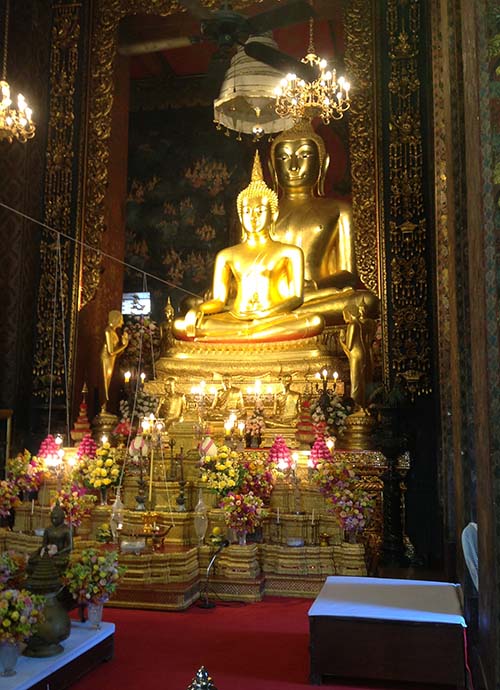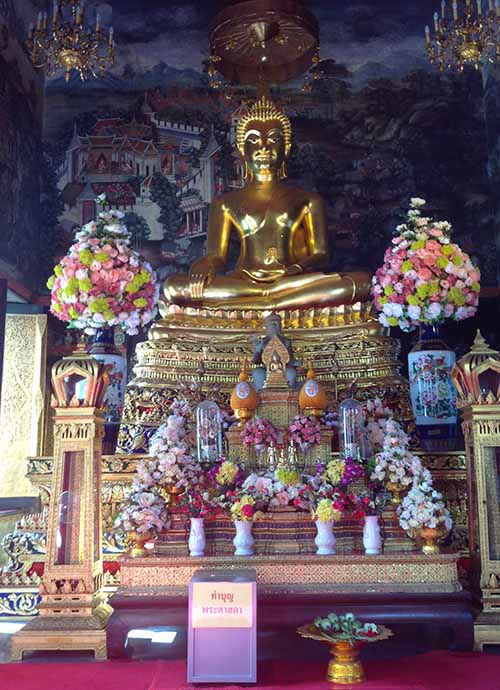
Wat Bowonniwet
Bangkok
Wat Bowonniwet, or Wat Bowon for short is a first class Royal temple in Bangkok’s Phra Nakhon district.
The temple, which is also known as Wat Bovornives was built during the reign of King Nangklao (Rama III) in the first half of the 19th century, when it was called Wat Mai. Originally there were two temples separated by a canal, the Wat Rangsi Sutthawat and the Wat Mai. In 1923 the two temples were merged into the Wat Bowonniwet.
Center of the Dhammayuttika Nikaya
The Wat Bowon is the center of the Dhammayuttika Nikaya, an order of Theravada Buddhism founded by King Mongkut.
Strong ties with the Royal Family
The Wat Bowonniwet has strong ties with the Thai Royal Family. In 1836 Prince Mongkut became the first abbot of the temple, which he remained until 1851 when he was crowned King Rama IV.
Several other members of the Royal Family lived in the temple, including King Bhumibol Adulyadej (Rama IX).
Structures of the Wat Bowonniwet
The Wat Bowonniwet is a large temple comprising of an ubosot, a chedi, several viharns, a Ho Trai or scripture library, a Bodhi tree building, several Royal residences, the kuti (monks living quarters) and a bell tower.
Chedi
The temple’s most noticeable structure, the 50 meter high golden chedi is the most important structure of the temple, since it enshrines sacred relics.
The chedi sits on an elevated base with a lower and upper terrace. The lower terrace contains depictions of celestial beings from Hindu mythology. At each of the corners of the terrace is a small prang (Khmer style tower) enshrining an image of the Buddha in the Abhaya (dispelling fear) mudra.

Sacred relics
The hollow chedi is closed to the public, except on Wat Khao Phansa day, usually in July. Inside are five small golden chedis that contain sacred relics. The central one is set on a stone base. On its four sides are carvings of four of the most important events in the life of the Buddha, namely birth, enlightenment, first sermon at the deer park in Sarnath and passing into Nirvana.
Scripture library
Near the chedi is the Ho Trai, the temple’s scripture library. Ancient boxes store the Tripitaka, the ancient Buddhist texts written on dried palm leaf. The Ho Trai’s walls are adorned with murals.
Ubosot
The ubosot or ordination hall was built during the reign of King Rama III. The entrance door is richly decorated with gilded carvings depicting guardians. Murals from the second half of the 19th century depict stories from the Buddhist teachings.
Two large golden Buddha images
The ubosot enshrines two large golden Buddha images.
Seated on a pedestal is the Wat Bowonniwet’s principal Buddha image, the Phra Phuttha Chinasi. The Sukhothai style image in the “Calling the Earth to Witness” posture was moulded in 1357.
Originally enshrined in the Wat Phra Si Rattana Mahathat temple in Phitsanulok, the image was moved to the Wat Bowonniwet in the early 19th century. The image is flanked by two standing images in adoration.
Seated in front of the Phra Phuttha Chinasi are three small images of former abbots of the temple. Behind it is another, larger Buddha image named Luang Phor To.

Inside the ubosot
Viharn Geng and Viharn Phra Sasada
Next to a group of Chinese style buildings are two viharns standing next to each other, the Viharn Geng and the Viharn Phra Sasada. The Viharn Geng contains three images of the Buddha, the base of one of them contains some of the ashes of King Mongkut.
The Viharn Phra Sasada consists of two rooms. The front room contains the Phra Sasada Buddha image, after which the viharn was named. In front of it is an ancient Mon Dvaravati era stone Buddha image. The room in the back of the viharn contains a reclining Buddha image named Phra Saiya. The wall behind the image is adorned with murals depicting followers in admiration.
Bodhigara, the Bodhi tree building
Near the Viharn Geng and Viharn Phra Sasada is a building known as Bodhigara, a structure to protect a Bodhi tree. The original tree which is believed to be an offspring of the tree under which the Buddha reached enlightenment some 2,500 years ago was planted by King Mongkut. Since this tree has not survived, King Bhumibol planted another tree, which is also an offspring of the Bodhi tree in India.
Phra Tamnak residences
The grounds of the Wat Bowonniwet contain several Phra Tamnak buildings, residences for Royalty or high ranking Buddhist monks.
Originally built in the Grand Palace, the Phra Tamnak Panya was moved to the Wat Bowonniwet by King Rama III in 1836 to be the residence for Prince Mongkut after he became the abbot of the temple. Several Kings lived in the Phra Tamnak Panya building, including King Bhumibol Adulyadej who was a monk in the Wat Bowonniwet for a while. The building is a mix of Thai, Chinese and European styles.
The Phra Tamnak Phet was built by King Vajiravudh (Rama VI) in 1914 as a residence for the temple’s third abbot. The building is now used for various ceremonies. The Phra Tamnak Phet is a very attractive building in a mix of Thai and European architectural styles; its name translates to “Royal diamond residence”.
The Phra Tamnak Lang and Phra Tamnak Chan were built over a century ago by order of King Chulalongkorn. Previously residences for high ranking monks, the buildings are now used for official functions.

Location
The temple is located on Phra Sumen road in Bangkok’s Phra Nakhon district.
How to get to the Wat Bowonniwet
You can get there by river boat, taxi or tuk tuk.
There is no BTS Sky Train station nearby.
Taxi or tuk tuk
The easiest and most comfortable way to get there is by metered taxi. The ride from the Grand Palace area should cost between 50 and 100 Baht depending on traffic.
If you are close to the temple, you can take a tuk tuk.
River boat
The nearest Chao Phraya river boat pier is Phra Athit on the orange line. From there, it’s about 700 meters away.
Opening hours
The temple opens daily from 6 am until 6 pm.
The Wat Bowonniwet is an important Royal temple, please dress appropriately which means no revealing clothes.
Entrance fee
Admission is free.